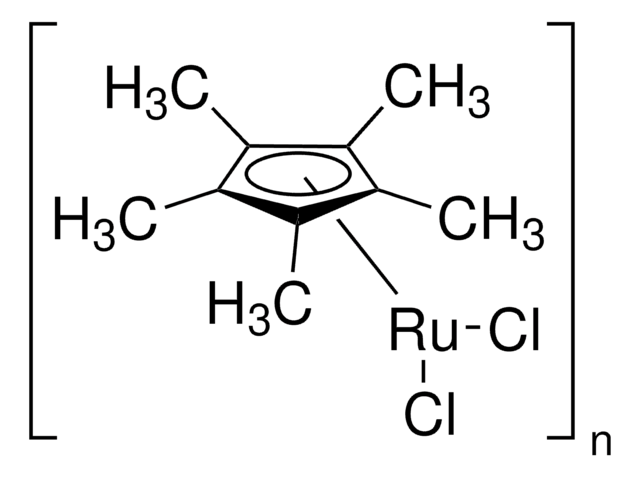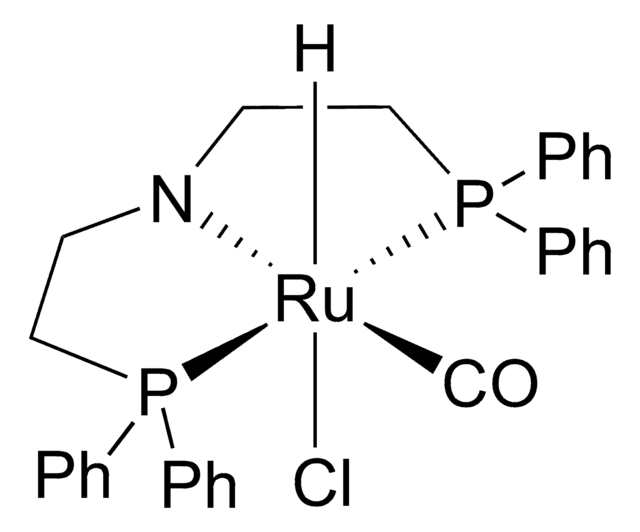If this product has an expiration or retest date, it will be shown on the Certificate of Analysis (COA, CofA). If there is no retest or expiration date listed on the product's COA, we do not have suitable stability data to determine a shelf life. For these products, the only date on the COA will be the release date; a retest, expiration, or use-by-date will not be displayed.
For all products, we recommend handling per defined conditions as printed in our product literature and website product descriptions. We recommend that products should be routinely inspected by customers to ensure they perform as expected.
For products without retest or expiration dates, our standard warranty of 1 year from the date of shipment is applicable.
For more information, please refer to the Product Dating Information document: https://www.sigmaaldrich.com/deepweb/assets/sigmaaldrich/marketing/global/documents/449/386/product-dating-information-mk.pdf
Kluczowe dokumenty
667234
Chloro(pentamethylcyclopentadienyl)(cyclooctadiene)ruthenium(II)
Synonim(y):
Cp*RuCl(cod), 1,5-Cyclooctadiene, ruthenium complex, Chloro(1,5-cyclooctadiene)(η5-pentamethylcyclopentadienyl)ruthenium, Chloro(1,5-cyclooctadiene)(pentamethylcyclopentadienyl)ruthenium
About This Item
Polecane produkty
przydatność reakcji
core: ruthenium
reagent type: catalyst
Poziom jakości
mp
143-147 °C
temp. przechowywania
−20°C
ciąg SMILES
Cl[Ru].C1CC=CCCC=C1.C[C]2[C](C)[C](C)[C](C)[C]2C
InChI
1S/C10H15.C8H12.ClH.Ru/c1-6-7(2)9(4)10(5)8(6)3;1-2-4-6-8-7-5-3-1;;/h1-5H3;1-2,7-8H,3-6H2;1H;/q;;;+1/p-1/b;2-1-,8-7-;;
Klucz InChI
MQMQNIQJGNBEMG-ONEVTFJLSA-M
Powiązane kategorie
Zastosowanie
It can be used:
- To catalyze cyclotrimerization of alkynylboronates, propargyl alcohols, and terminal alkynes to form arylboronate, which in turn undergoes palladium(II)-catalyzed carbonylation to form highly substituted phthalides.[2]
- To catalyze C-C coupling of norbornenes and norbornadiene with alkynes to form [2 + 2] cycloadducts.[3]
- In combination with 2-diphenylphosphinoethylamine-potassium tertiary butoxide to form a ternary catalyst system that can catalyze fast racemization of chiral non-racemic sec-alcohols.[4]
- To synthesize new organoruthenium complexes with phosphorus-based ligands such as bis(phosphino)amines.[5]
- To catalyze the addition of organic disulfides to alkenes leading to vic-dithioethers.[6]
Hasło ostrzegawcze
Danger
Zwroty wskazujące rodzaj zagrożenia
Zwroty wskazujące środki ostrożności
Klasyfikacja zagrożeń
Water-react 2
Kod klasy składowania
4.3 - Hazardous materials which set free flammable gases upon contact with water
Klasa zagrożenia wodnego (WGK)
WGK 3
Temperatura zapłonu (°F)
Not applicable
Temperatura zapłonu (°C)
Not applicable
Środki ochrony indywidualnej
Eyeshields, Gloves, type P3 (EN 143) respirator cartridges
Wybierz jedną z najnowszych wersji:
Masz już ten produkt?
Dokumenty związane z niedawno zakupionymi produktami zostały zamieszczone w Bibliotece dokumentów.
Klienci oglądali również te produkty
-
How can I determine the shelf life / expiration / retest date of this product?
1 answer-
Helpful?
-
-
How is shipping temperature determined? And how is it related to the product storage temperature?
1 answer-
Products may be shipped at a different temperature than the recommended long-term storage temperature. If the product quality is sensitive to short-term exposure to conditions other than the recommended long-term storage, it will be shipped on wet or dry-ice. If the product quality is NOT affected by short-term exposure to conditions other than the recommended long-term storage, it will be shipped at ambient temperature. As shipping routes are configured for minimum transit times, shipping at ambient temperature helps control shipping costs for our customers. For more information, please refer to the Storage and Transport Conditions document: https://www.sigmaaldrich.com/deepweb/assets/sigmaaldrich/marketing/global/documents/316/622/storage-transport-conditions-mk.pdf
Helpful?
-
Active Filters
Nasz zespół naukowców ma doświadczenie we wszystkich obszarach badań, w tym w naukach przyrodniczych, materiałoznawstwie, syntezie chemicznej, chromatografii, analityce i wielu innych dziedzinach.
Skontaktuj się z zespołem ds. pomocy technicznej








![Dichlorotriphenylphosphine[2-(diphenylphosphino)-N-(2-pyridinylmethyl)ethanamine]ruthenium(II) 97%](/deepweb/assets/sigmaaldrich/product/structures/303/584/056e7e0c-3dde-4c68-9250-78fed40d37cb/640/056e7e0c-3dde-4c68-9250-78fed40d37cb.png)





